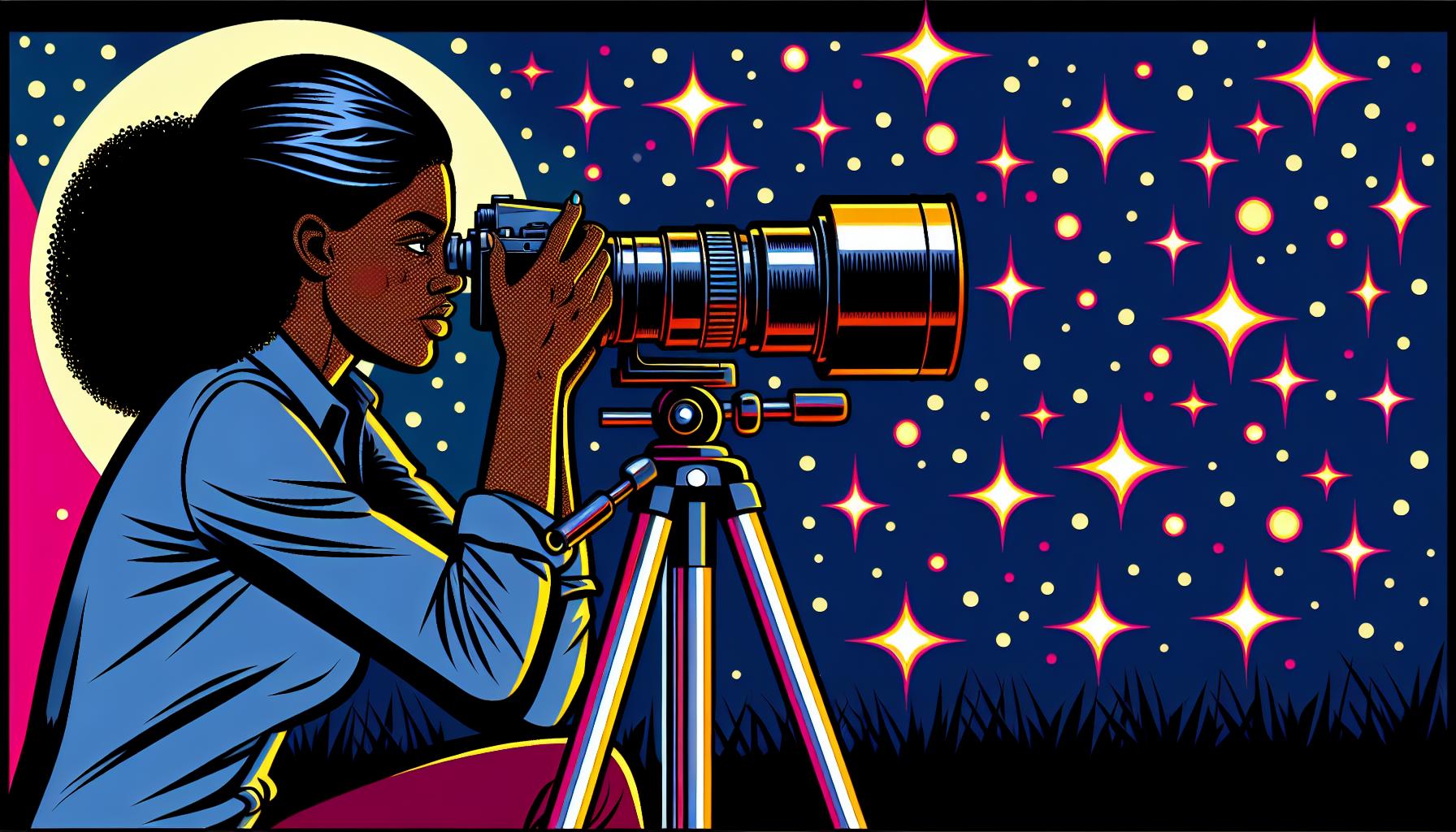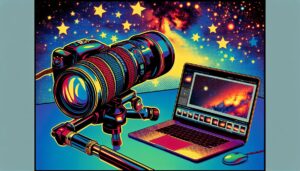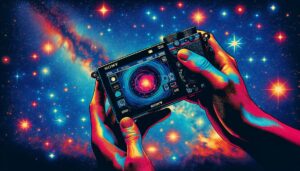This site contains affiliate links to products. I may receive a commission for purchases made through these links.
Capturing the night sky’s beauty is no small feat. But with astrophotography, it’s possible. Focusing in astrophotography, however, is a different ball game. It’s tricky, yet vital for stunning shots.
I’ve spent years mastering this art, and I’m here to share my insights. From choosing the right equipment to perfecting the focus, I’ll guide you through it all. So, let’s dive into the world of stars and galaxies together.
Remember, astrophotography isn’t about snapping a quick pic. It requires patience, precision, and a keen eye for detail. But don’t worry, with the right techniques, you’ll be capturing the cosmos like a pro in no time.
Choosing the Right Equipment
First thing’s first, you can’t shoot the stars with just any old camera. Astounding astrophotography demands specialized gear. It’s an investment, to be sure, but the dazzling results are worth every penny.
In my experience, a single-lens reflex (SLR) or a mirrorless camera allows for the kind of control you need. These cameras allow you to tinker with aperture, ISO, shutter speed, and other settings to perfect your shot. Since we’re gathering light from billions of miles away, a fast lens with a wide aperture (f/2.8 or wider) helps harness more of that celestial glow.
Camera Bodies Matter
Don’t overlook the importance of the camera body. Try for a model with a large sensor since they capture more information and reduce noise. Cameras designed for low light or high ISO settings excel at astrophotography. When it comes to sensor sizes, bigger is always better.
Don’t Skimp on the Mount
For those long exposure shots, a top-notch mount becomes your best friend. A typical tripod won’t cut it – you’re capturing stars, not still life. What you need is a specially designed astrophotography mount. These specialized mounts compensate for the Earth’s rotation. Without one, long exposure shots blur as our planet spins on.
A motorized, equatorial mount helps keep the night sky centered in your frame, countering the movement of the stars due to Earth’s rotation. These mounts can be complex, but once you’ve got the hang of it, they’ll open up a whole new world of possibilities.
In the grand scheme of things, the perfect snapshot is a blend of the right tool and the photographer’s skillset. It’s all about balancing equipment choices with your budget and skill level. While state-of-the-art gear can deliver incredible shots, don’t forget – it’s you who captures the magic. With patience, precision, and a solid grasp on your equipment, the cosmos is yours to capture.
Understanding Manual Focus
Diving deeper into the nitty-gritty of astrophotography, it’s time to tackle an essential element: manual focus. Unlike regular photography where automatic focus does the job, astrophotography calls for precision. Here’s where manual focus steps into the spotlight.
So what’s the deal with manual focus? Let’s break it down. When shooting stars, you need to set your focus at infinity. Contrary to what you’d expect, leaving your lens on the “infinity” marker won’t yield sharp stars. Most lenses do not have their true infinity focus right at the marking, due to variations in temperature and atmospheric conditions. So, you’ll need to adjust this each time you shoot. This is the beauty of manual focus – it gives you the power to nail down the perfect setting for your specific situation.
How do you go about it? Start by setting your lens to manual focus mode and dialing in the “infinity” mark. Point it towards a bright star. Now magnify your live view screen as much as possible and slowly adjust your focus ring back and forth until the star appears as small and sharp as possible.
By now, you might be wondering about focus aids like focus peaking or automatic focus features. It’s true, some modern cameras do offer these features. Yet, I still urge you towards mastering manual focus first. These aids can be helpful but nothing beats the skill and control manual focus provides. They may be effective in some scenarios but when it comes down to capturing the vastness of a star-filled sky with unmatched clarity, manual focus is your surefire bet.
Ensuring crisp and clear images of distant celestial bodies is the goal. Now equipped with these insights, the task of manual focusing in astrophotography may initially seem daunting but with practice, it will soon become second nature. The night sky waits for no one, so grab your gear and start practicing your focusing skills. Time spent understanding the art of manual focus is an investment in epic star-filled frames.
Achieving Sharp Focus
In astrophotography, achieving sharp focus is the name of the game. A blurred starry sky is a surefire way to ruin your shot. You might wonder, “Why so strict with the focus?” Our human eyes, while impressive, simply can’t match the resolution of a camera sensor. Precise focusing is particularly vital in astrophotography because you’re capturing minute points of light against a dark sky.
So, the question is – how to get that perfect focus in astrophotography? One critical factor here is “infinity focus.” The concept sounds complicated, but it’s quite straightforward. In photography, “infinity” refers to the farthest possible point in your field of vision. For astrophotography, that point is, of course, stars billions of miles away.
Setting your lens to infinity focus doesn’t mean you’re done, however. Depending on your specific camera and lens combination, the infinity point might be slightly before or after the designated mark on your lens. This is where the real fun begins.
Practicing is key for offline tuning to identify the sweet spot. Take your gear out on a clear night and experiment implementing small adjustments to your focus. One handy technique I have found beneficial is the “focus and zoom” method. After you’ve set your lens at or near infinity, take a shot and then zoom in on the image on your camera’s LCD screen. If the stars appear as small points of light, you’ve nailed the focus. If not, make small adjustments and repeat until you get it right.
But there’s more to it. The Earth’s rotation, atmospheric conditions and your camera’s sensor size also play crucial roles. These factors combine to affect what astrophotographers call the “circle of confusion”. The larger the sensor, and the narrower the aperture, the smaller the circle of confusion – and hence, sharper stars.
Moreover, using an astrophotography mount can radically improve your craft. A mount can compensate for Earth’s rotation, decreasing star trails – a common issue in long exposure night photography. It’s not a cheap investment, but if you’re serious about astrophotography, it’s an equipment upgrade worth considering.
The process sounds deep, and to be honest, it is! But isn’t that why we find astrophotography so fascinating? Let’s deep dive into some more nuances of this art in the next section.
Dealing with Lens Distortion
As we dive deeper into the science and art of astrophotography, another crucial factor that often challenges photographers is lens distortion. Lens distortion is an optical effect resulting in the deformation of objects in the image. It’s particularly noticeable in the corners of wide-angle shots, where stars may appear to stretch or take elliptical shapes.
The type of lens you use plays a significant role in this distortion. Wide-angle lenses, being the popular choice for capturing wide swathes of the night sky, have this tendency. Distorted stars in the corners of your images can distract from the beauty of a perfectly composed Milky Way shot.
So, what can we do to minimize this problem?
Lens Choice and Aperture Settings
A fundamental step in reducing lens distortion is through the choice of lens and proper aperture settings. The sweet spot of your lens, generally between f/2.8 and f/4 for most wide-angle lenses, can help you achieve sharper, more circular stars.
Using a lens-profile correction feature in software such as Adobe Lightroom can also help reduce distortion. However, it’s essential to remember that this may not entirely correct the problem and can even lead to loss of sharpness in some scenarios.
Star Reduction Techniques
Another method to deal with lens distortion in astrophotography is through star reduction techniques. They reduce the visibility of star distortion without affecting the overall impact of the night sky in your image. Some popular star reduction techniques include:
- Minimum filter technique
- Masking and layering process
Remember, dealing with lens distortion in astrophotography is not solely about equipment or techniques but the blend of both. Our exploration across the cosmos through the lens continues to approach other variables that will help us master this art. My next discussion will dwell more on the technicalities of exposure settings in different atmospheric conditions.
Tips for Night Sky Autofocus
Right on the heels of discussing lens distortion, let’s delve into the daunting world of autofocus in astrophotography. While autofocus might seem hard to master, with the right techniques, it becomes a walk in the park.
Firstly, navigating night photography and maintaining sharp focus usually requires ditching your camera’s autofocus feature. Autofocus often struggles in low light and can give blurred images as it hunts for focus. However, there are a few situations when the technology comes in handy.
- When shooting brighter objects like the moon, some cameras can handle autofocus effectively.
- If there’s a bright star or planet in the frame, autofocus might also work well.
Once the autofocus is done, you can then switch to manual to ensure the focus doesn’t shift.
Talking about manual focus, while working on astrophotography, one often uses the “Live View” mode. This might cause some strain on your eyes. With autofocus, you can use a bright star or the moon to achieve initial focus, then switch to live view to fine-tune it. Less strain on your eyes, more accuracy in your shots!
Conclusion
I’ve walked you through the ins and outs of focusing in astrophotography. Remember, autofocus isn’t your only ally in low light conditions; manual focus can be a game-changer. It’s about starting with autofocus, then fine-tuning with live view mode.
Don’t be afraid to experiment; it’s how you’ll find what works best for your setup. As we move forward, we’ll delve into how atmospheric conditions can influence exposure settings. But for now, take these tips and start capturing the night sky like never before. It’s time to let your astrophotography skills shine.
Frequently Asked Questions
Why is achieving sharp focus in night sky photography challenging?
Achieving sharp focus for night sky photography can be challenging due to low light conditions. Most cameras struggle to autofocus in such situations, which could result in blurred or out-of-focus images.
Can I rely solely on autofocus for nightscape photography?
Relying solely on autofocus isn’t recommended for astrophotography. While it can help achieve an initial focus, manual adjustments are often necessary to get sharp and crisp images.
How do atmospheric conditions affect exposure settings in astrophotography?
Atmospheric conditions play a significant role in adjusting the exposure settings for astrophotography. Different conditions like humidity, temperature, and light pollution impact how light interacts with your camera, thus affecting the exposure settings.




